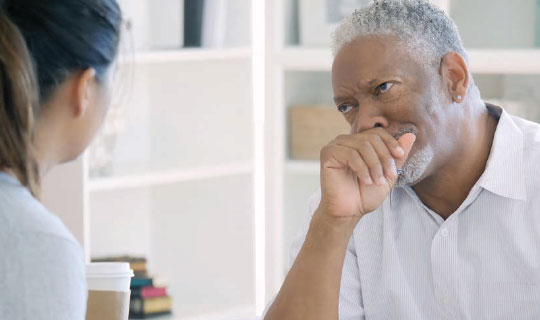Seasonal depression is a struggle, but help is available.
 In winter, the short hours of daylight can lead to dark moods. It’s a common syndrome—thought to affect up to 10 million people in the U.S—known as Seasonal Affective Disorder, or SAD. “SAD is a kind of depression that happens at a specific time of year, usually in the winter,” explains psychiatrist Gabriel Kaplan, MD, Chief Medical Officer of the RWJBarnabas Health Behavioral Health Network. Symptoms of SAD are similar to those of clinical depression, such as feelings of hopelessness, anxiety and problems with appetite. “A couple of symptoms seem to be more common with SAD, however,” says Dr. Kaplan. “People with SAD often crave sweets more, and are more tired and sleep more.”
In winter, the short hours of daylight can lead to dark moods. It’s a common syndrome—thought to affect up to 10 million people in the U.S—known as Seasonal Affective Disorder, or SAD. “SAD is a kind of depression that happens at a specific time of year, usually in the winter,” explains psychiatrist Gabriel Kaplan, MD, Chief Medical Officer of the RWJBarnabas Health Behavioral Health Network. Symptoms of SAD are similar to those of clinical depression, such as feelings of hopelessness, anxiety and problems with appetite. “A couple of symptoms seem to be more common with SAD, however,” says Dr. Kaplan. “People with SAD often crave sweets more, and are more tired and sleep more.”
As with regular depression, there is help for those who suffer from SAD.
Why Winter?
While the exact cause of SAD is unknown, two hormones are implicated: melatonin, the hormone that regulates sleep, and serotonin, a key hormone for mood stabilization. “Melatonin tends to be produced when there’s no sunlight,” explains Dr. Kaplan. “More melatonin means people feel sleepier.” Conversely, sunlight tends to boost serotonin. A lack of light causes the brain to release less serotonin, which can lead to depression.
“We’re not sure what makes some people vulnerable to SAD while others aren’t greatly affected by less exposure to sunlight,” says Dr. Kaplan. “The theory is that people with SAD may have some form of imbalance in the regulation of these two hormones. Genetic factors may play a role in this.”
What to Do
“If you think you may have SAD, consult with a professional to determine whether your condition relates to that or to something else,” advises Dr. Kaplan. “Depression can be due to many different things, so it’s better not to self-diagnose and possibly waste time on the wrong treatments.”
Having a healthy diet and regular exercise have been shown to improve symptoms of depression. Other possible treatments for SAD include:
Light therapy. The patient sits or works near a device called a light therapy box, which gives off a bright light that mimics natural outdoor light. “For some people, this treatment is very effective, but it’s best to consult your physician about the type of device to use,” says Dr. Kaplan.
Cognitive behavioral therapy. This kind of psychotherapy, or “talk therapy,” focuses on changing inaccurate or negative thinking in order to create new behaviors.
Antidepressant medication. “Generally speaking, antidepressants don’t start working for four to six weeks,” says Dr. Kaplan. “If your depression is seasonal, you may choose to take them for several months and then go off them when winter is over, or continue to take them for the rest of the year to prevent the reappearance of depression. It’s the combined job of the doctor and patient to decide the best course.”
To learn about options for getting help for depression, click here or call the RWJBarnabas Health Behavioral Health Network Access line at 800.300.0628.